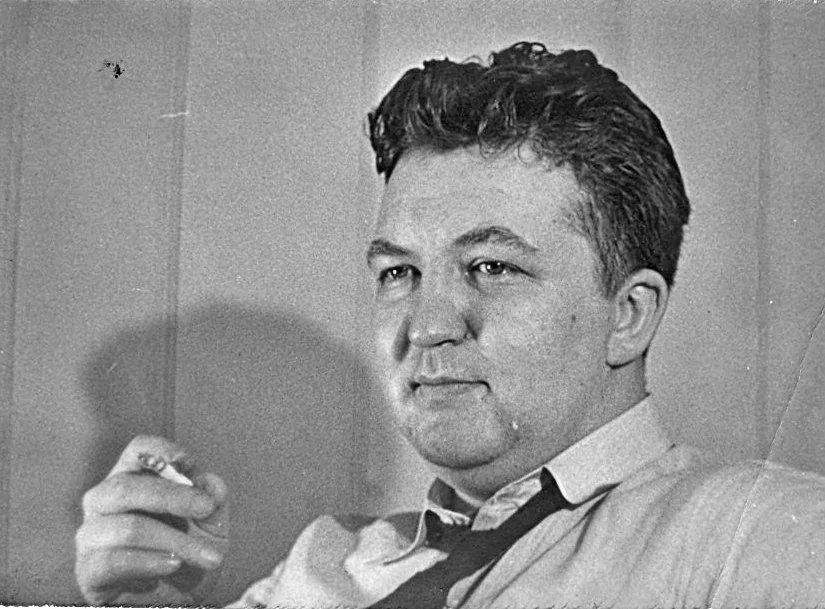THE GAME - KRIEGSPIEL
What do Game Theorists do for sport? They play games! They seek the thrill of competing, winning or losing! Against whom? Their pals from the office! Kriegspiel was Lloyd Shapley's favorite game. He played in the Rand lunch hour matches. He nearly always won.
KRIEGSPIEL INTROduction in honor of lloYD
This video was made by Dr. Bruce E. Krell, another Kriegspiel lunchtime player at Rand. Krell offers this tutorial so more people can learn to play/fight/win-or-lose - and kibbitz - at Kriegspiel, “the ultimate brain teaser.” There are Kriegspiel clubs in Los Angeles and in the UK. If you belong to a Kriegspiel club or want more info, please go to Contact.
HOW IT WORKS
The photo below shows that between the two player's’ boards is a screen between that prevents them seeing from their opponent’s actual moves.
You see your own chess pieces on your board. On your board you set the other person’s pieces where you think they are. But the other player’s pieces are invisible to you. You have to imagine where they could be, think back to the Referee’s cryptic calls. Then you dare move a piece to probe the other side’s locations. Disaster can strike fast.
Krell says: “Games are lively. Players harass each other. Kibitzers harass both players. Post-game analysis by both players and the kibitzers is generally lively and exciting. Fragile egos will not survive Kriegspiel!”
LLOYD’S STYLE “LIKE ESP”
Kriegspiel being played at RAND in the 1950s. Lloyd Shapley is not shown. Photo: The RAND Corporation
Lloyd at Kriegspiel was dubbed “Knight of the Gnarled Fist.” Sylvia Nasar in A Beautiful Mind, The Life of Mathematical Genius and Nobel Laureate John Nash quotes two Princeton friends. First from Marvin Minsky:
“He was a fiercely competitive and accomplished player of Kriegspiel and everybody knew that his game was strictly his own. It was like ESP. Shapley seemed to know where all of the pieces were all of the time.”
From Melvin Hausner: “He went out of his way to find nonstandard moves. No one was going to anticipate them,”
Below is what Lloyd’s friend and colleague Martin Shubik said, from Pradeep Dubey’s reminiscence on the STORIES page:
“ No matter what happens in the game, Lloyd always wins the analysis.””
THE BOSS WROTE SOME RULES
John D. Williams, head of the Mathematics Department at RAND. Besides brilliant hiring and use of talented people, Williams wrote “Rules for Kriegspiel” that Lloyd and others used through the 1980s. Photo: The RAND Corporation
The RAND Corporation was formed in 1948 by the Douglas Aircraft Company to offer research and analysis to the US military in the new Cold War environment. (Think: “Dr. Strangelove”) John D. Williams pushed for a cutting-edge mathematics division to support modeling cold war problems (Think: Soviet bomber strikes) and other military and government issues.
Williams hired many who became legends in US math and economics including the young Lloyd Shapley. (Other names: John Milnor, John Nash, Kenneth Arrow, Paul Samuelson, Robert J. Aumann, Thomas C. Schelling). For a profile of Williams see S. Nasar Beautiful Mind.
Williams encouraged the lunchtime Kriegspiel games. In 1950 he set out some rules to be followed by the all-important Referee. Williams’ “Rules of Kreigsspiel” are in Lloyd Shapley’s little paper “The Invisible Chessboard” not previously published. Kriegspiel-rules-and-Lloyd-Shapley-demo.pdf
LLOYD’S OTHER GAMES
Clockwise from upper left: GO (Shutterstock); SUMMIT (Etsy-PatinaPatina); SO LONG SUCKER (Video by Anthony Cholag); DIPLOMACY (Waddington’s buyfromgroovy.com).
GO - Lloyd played Go fiercely, but he did not invent it. The game was invented by the Chinese thousands of years ago as Weiqi. Players take turns placing their discs trying to surround more area while blocking their opponent from doing so. The player who has surrounded the greatest area of empty board wins.
SUMMIT - Lloyd did invent Summit (pub. 1961, design by Olaf Helmer). Tagline: "The whole world is up for grabs in the Cold War. Each player (a major power) allocates resources to building military bases, steel mills, or factories at home or abroad....The players accumulate chips representing their power and use these chips to pressure other players…Alliances can be precarious but only one player can win.”
DIPLOMACY - It was said that Lloyd invented Diplomacy (pub. 1959) but Wiki credits Allan Calhamer. Anyhow Lloyd enjoyed this “exciting game of international intrigue." The players are the seven Great Powers of Europe negotiating like mad in the run-up to World War One.
SO LONG SUCKER - A four-person bargaining game invented by Mel Hausner, John Nash, Lloyd Shapley, and Martin Shubik in 1950. From Wiki: A player “must make agreements with other players which are unenforceable. To win, players must eventually go back on such agreements. Coalitions, or agreements to cooperate, are permitted…There is no penalty for failure to live up to an agreement.”


